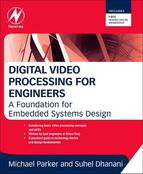Table of Contents
2. Introduction to Video Processing
2.1 Digital Video: Pixels and Resolution
2.2 Digital Video: Pixels and Bits
2.3 Digital Video: Color Spaces
2.4 Video Processing Performance
4. Introduction to Digital Filtering
4.4 Computing Frequency Response
5.1 Understanding Video Scaling
5.2 Implementing Video Scaling
5.3 Video Scaling for Different Aspect Ratios
6.1 Basic Deinterlacing Techniques
6.2 Motion-Adaptive Deinterlacing: The Basics
7.2 Concept and Math Behind Alpha Blending
7.3 Implementing Alpha Blending in Hardware
7.4 Creating a Different Background
8. Sensor Processing for Image Sensors
8.2 A Simplistic HW Implementation of Bayer Demosaicing
8.3 Sensor Processing in Military Electro-optical Infrared Systems
11. Entropy, Predictive Coding and Quantization
12. Frequency Domain Representation
12.3 Discrete Cosine Transform
13. Image Compression Fundamentals
14. Video Compression Fundamentals
14.7 Rate Control and Buffering
14.8 Quantization Scale Factor
15. From MPEG to H.264 Video Compression
15.2 H.264 Video Compression Standard
15.3 Digital Cinema Applications
16. Video Noise and Compression Artifacts
17. Video Modulation and Transport
17.1 Complex Modulation and Demodulation
17.2 Modulated Signal Bandwidth
18.1 Basics of Internet Protocol (IP)
18.6 Video Over Internet Issues
20. Memory Considerations When Building a Video Processing Design
20.2 Calculating External Memory Bandwidth Required
20.3 Calculating On-Chip Memory
21. Debugging FPGA-based Video Systems
21.2 The SystemConsole Debugger
21.3 Check That Clocks and Resets are Working
21.4 Clocked and Flow Controlled Video Streams
21.6 Converting from Clocked to Flow-controlled Video Streams
21.7 Converting from Flow-controlled to Clocked Video Streams
21.8 Free-running Streaming Video Interfaces
21.9 Insufficient Memory Bandwidth
